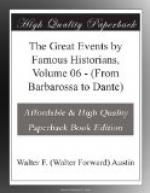History teaches that where commerce and industry flourish, art also secures its triumphs. The glorious Gothic cathedrals of the Hanseatic cities bear eloquent testimony to this truth. “The Northlander who entered the Trave or the Vistula and beheld the multitude of soaring church spires must have felt as did once the German pilgrim to Rome,” says a modern investigator. The principal representative and patron of this art culture, here as elsewhere during the Middle Ages, was the Church. But the splendid town halls as well as the few private mansions preserved, with their step-like aggregation of gables, afford convincing evidence alike of the solid appreciation of art as of the love of splendor which characterized that distant generation. Certain it is that they greatly surpassed us in the domain of Gothic architecture. Owing to the strict adherence to the Catholic dogma a scientific development in the modern sense was, of course, impossible in those days; and, although most of the parish churches had their schools also, these were commonly designed chiefly for the sons of patricians, whose schooling usually embraced a little Latin and some reading, writing, and singing. Not infrequently the only scholar in the place was the town clerk, the forerunner of our present recorder.
The robust, healthy German of that day, yielding to a tendency which has characterized our people from immemorial times, preferred the more to surrender himself to a life of solid comfort and good cheer. The Middle Age was one which inclined to favor the enjoyment of life. It is but necessary to consider the variegated costumes, rich in color, whose ultimate extravagances necessitated special dress regulations, as well as the tournaments, the numerous archer festivals, and the frequent masquerades, to realize that the people of that day appreciated the good things of life. On the occasion of baptisms, weddings, and other domestic events, great feasts were frequently arranged in the house of the guilds or even in the town hall; and many princely visitors were here also entertained at the expense of the municipal budget. The administration of the cellarage of the municipal council was also then considered a far more respectable post than now. All these facts attest the prosperity of the Hanseatic towns. Fortunes of one hundred thousand marks were by no means exceptional, and were often invested in neighboring knightly estates (feofs), thereby sometimes securing to the owner an eventual admission to the ranks of the nobility. At one time—i.e., after the great Hanseatic war—the city of Lubeck owned the entire dukedom of Lauenburg.




